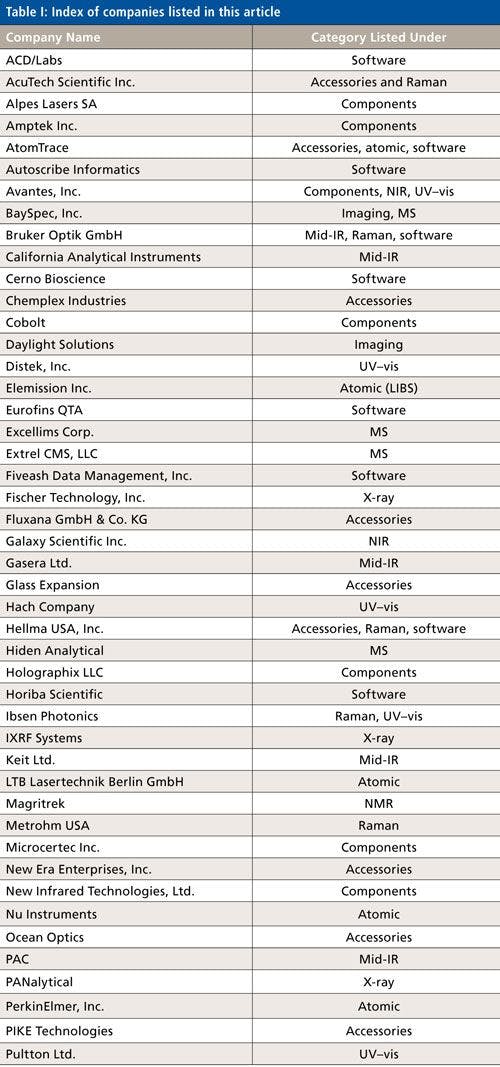The C-O Bond III: Ethers By a Knockout
Spectroscopy
We will discuss three different types of ether, which are characterized by the type of carbons attached to the central oxygen.
We discuss three different types of ether, which are characterized by the type of carbons attached to the central oxygen.
A few issues ago we started our survey of the infrared (IR) spectroscopy of the C-O bond (1), and proceeded to study the spectra of alcohols and phenols (1,2). Now that we are finished with these molecules the next functional group to study that contains the C-O bond is ethers. Ethers are characterized by a central oxygen atom with two carbons attached, as shown in Figure 1.
Figure 1: The chemical structure of the ether functional group.

Note that unlike alcohols ethers contain not one but two C-O bonds. The carbons in these bonds are referred to as ether carbons as shown in the figure. Because ethers do not contain an -OH bond there is no significant hydrogen bonding and there are no -OH stretching or bending peaks. In fact, the only useful group wavenumbers for ethers are their C-O stretching peaks as discussed below.
Here we discuss three different types of ether, which are characterized by the type of carbons attached to the central oxygen. If both ether carbons are saturated then we have a saturated ether, if both ether carbons are aromatic that gives an aromatic ether, and if one ether carbon is saturated and one is aromatic it is a mixed ether.
The IR Spectroscopy of Ethers
Since all ethers contain a C-O-C linkage, the vibration that we would usually refer to as a “C-O” stretch actually involves the asymmetric stretch of the C-O-C moiety as shown in the left side of Figure 2.
Figure 2: The asymmetric and symmetric C-O-C stretches of the ether functional group.

This vibration is analogous to the C-C-O asymmetric stretch of alcohols, and like alcohols these peaks are typically the largest ones found between 1300 and 1000 cm-1 (for the rest of this installment assume all peak positions quoted are in cm-1 units if not specified). The C-O-C linkage can also undergo a symmetric stretch as shown in the right side of Figure 2. This peak is typically not as intense as the C-O-C asymmetric stretch because du/dx for the symmetric stretch is less than that for the asymmetric stretch (3). This peak typically falls between 890 and 820. It is an example of a secondary band as discussed previously (4). That is, it is not intense and shows up in a busy spectral region, so by itself it is not diagnostic. However, after an ether C-O-C asymmetric stretch is identified the symmetric stretch should be assigned to keep from mistaking it as being from a different functional group.
Saturated Ethers
The IR spectrum of a saturated ether, diethyl ether, is shown in Figure 3.
Figure 3: The IR spectrum of diethyl ether, C4H10O.
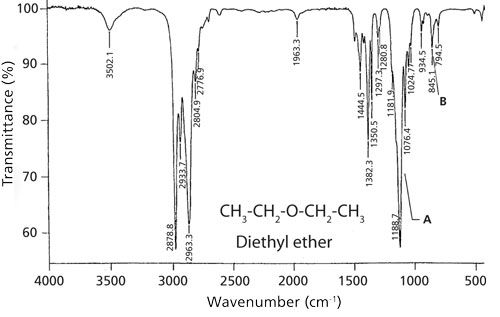
This compound was the first of its class discovered and was originally just called “ether,” hence the name for this entire family of molecules. Diethyl ether is a common organic solvent and was the first substance used as an anesthetic in human surgery. Although this compound is rarely used as an anesthetic today, many modern anesthetics still contain ether linkages, hence the reference to being knocked out in the title.
Although there are many peaks in the spectrum of diethyl ether, the only one that is diagnostic for it being an ether is the C-O-C asymmetric stretch labeled A at 1122. For saturated ethers, generally this peak falls at between 1140 and 1070. Note that this peak is easily the largest one between 1300 and 1000 as expected for C-O stretches. The symmetric C-C-O stretch falls at 845. Also note that it is significantly lower in intensity than the asymmetric C-C-O stretching peak, as expected.
Mixed Ethers
The IR spectrum of a mixed ether, methyl phenyl ether or anisole, is shown in Figure 4.
Figure 4: The IR spectrum of anisole, C7H8O, a mixed ether.
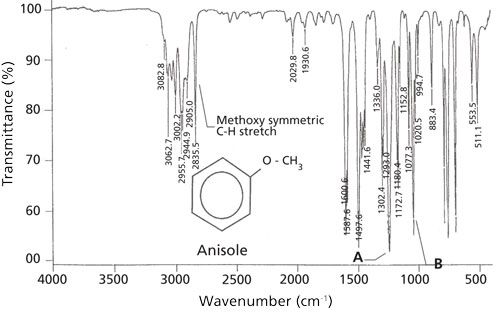
This molecule is a mixed ether because one of the ether carbons is part of a methyl group and is saturated, while the other ether carbon is part of a benzene ring and hence is aromatic. Unlike diethyl ether, the bonding around the ether oxygen is symmetric and there is only one C-O stretching peak. The bonding around anisole’s ether oxygen is asymmetric, meaning the two C-O bonds will be chemically different, have different force constants, and thus have different C-O stretching peak positions.
Figure 4 is one of the most complex spectra we have yet encountered. This complexity is caused by the molecule’s many functional groups, which include a methyl group, a monosubstituted benzene ring, and a mixed ether linkage. That being said, it is easy to assign this molecule as a mixed ether. If you look closely between 1300 and 1000 there is not one, but two intense bands. This pair of intense peaks is typical of mixed ethers. The two C-O stretching peaks can be thought of as being from the aromatic and saturated C-Os, respectively. Nominally, we can assign the aromatic C-O stretch as being at 1247, which is labeled A in the figure, and the saturated C-O stretch as being at 1040, which is labeled B in the figure.
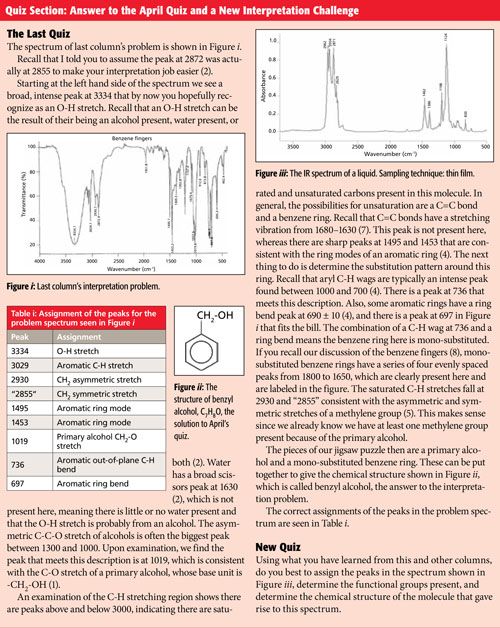
CLICK IMAGE TO ENLARGE
Aromatic Ethers
The IR spectrum of an aromatic ether, diphenyl ether, is shown in Figure 5.
Figure 5: The IR spectrum of an aromatic ether, diphenyl ether, C12H10O.
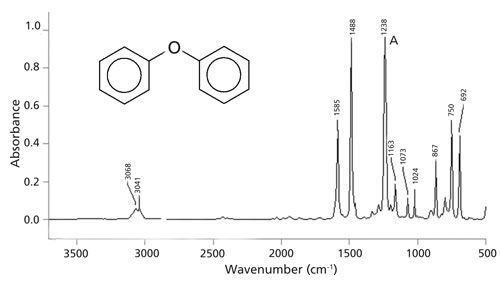
Like diethyl ether whose structure is shown in Figure 3, diphenyl ether is also symmetrical, the two C-O bonds are identical, and there is only one major peak between 1300 and 1000. This C-C-O asymmetric stretch is at 1238 in Figure 5 and is labeled A. For aromatic ethers, in general, this peak falls between 1300 and 1200. Note that for mixed ethers the “aromatic C-O stretch” as we called it also falls between 1300 and 1200. Take the C-O stretches of a mixed ether, remove the peak because of the saturated ether carbon, and you end up with the C-O stretch of an aromatic ether. The symmetric C-O-C stretch for this molecule falls at 867.
Diphenyl ether is an example of an “unsaturated only” molecule because all the carbons are part of an aromatic ring. As a result, all of the C-H stretches are above 3000 (5). This molecule also contains two mono-substituted benzene rings and thus exhibits ring modes at 1585 and 1488, an aryl C-H wag at 750, and the “ring bending” mode at 692 (6). Table I summarizes the group wavenumbers for saturated, mixed, and aromatic ethers.
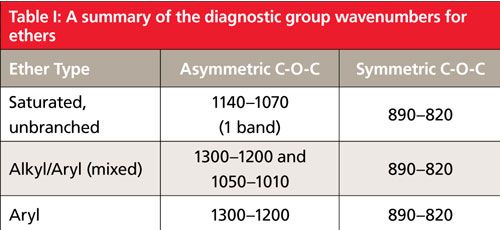
Methoxy Groups
A special type of ether is when one of the moieties attached to the oxygen is a methyl group. This functional group is called a methoxy group, short for methyl oxygen, whose structure is shown in Figure 6.
Figure 6: The chemical structure of the methoxy functional group.

This is the first time we have seen a methyl group attached to a noncarbon atom. Because of the oxygen, the C-H stretching peak positions change from what we normally expect for a methyl group. Specifically, the symmetric C-H stretch for a methoxy group falls at 2830 ± 10, whereas for a CH3-C group it falls at 2872 ± 10 (5). I didn’t mention it earlier, but the chemical structure of anisole, illustrated in Figure 4 along with its spectrum, contains a methoxy group. The methoxy symmetric C-H stretch as we call it falls at 2835 and is clearly labeled in the figure. Note that this peak is sharp, of medium intensity, and a little lower in wavenumber than most C-H stretches. These unique features make the methoxy C-H symmetric stretch an excellent group wavenumber, and the best indication in a spectrum that a methoxy group is present in a sample.
Summary
The diagnostic group wavenumbers for the ethers we have studied are listed in Table I. Ethers contain a central C-O-C linkage and hence have two C-O bonds. The three types of ether whose spectra were discussed were saturated, mixed, and aromatic, the type of ether being determined by the types carbons, known as ether carbons, attached to the oxygen atom. Unlike alcohols, ethers do not contain an -OH bond, and hence their only useful group wavenumbers are an asymmetric and symmetric C-O-C stretch. The asymmetric C-O-C stretch, like other peaks involving the C-O bond, is often the biggest peak between 1300 and 1000. The type of ether can be determined based on the number and position of this peak. For saturated ethers there is one C-C-O asymmetric stretch from 1140 to 1070, for mixed ethers there are two of these peaks at 1300–1200 and 1050–1010, and for aryl ethers there is one peak that falls from 1300 to 1200. When a methyl group is attached to an ether oxygen it is called a methoxy group. It has a unique symmetric C-H stretching peak at 2830±10 that is sharp and of medium intensity.
References
- B.C. Smith, Spectroscopy32(1), 14–21 (2017).
- B.C. Smith, Spectroscopy32(4), 19–23 (2017).
- B.C. Smith, Infrared Spectral Interpretation: A Systematic Approach (CRC Press, Boca Raton, Florida, 1999).
- B.C. Smith, Spectroscopy31(7), 30–34 (2016).
- B.C. Smith, Spectroscopy30(4), 18–23 (2015).
- B.C. Smith, Spectroscopy30(7), 26–31 (2015).
- B.C. Smith, Spectroscopy31(11), 28–34 (2016).
- B.C. Smith, Spectroscopy31(9), 30–33 (2016).

Brian C. Smith, PhD, is the West Coast Business Development Manager for CAMO Software, a company that sells chemometric, multivariate analysis, and process control software. Before joining CAMO, Dr. Smith ran his own FT-IR training and consulting business for more than 20 years. Dr. Smith has written three books on infrared spectroscopy: Fundamentals of FTIR and Infrared Spectral Interpretation, both published by CRC Press, and Quantitative Spectroscopy: Theory and Practice published by Academic Press. He can be reached at: SpectroscopyEdit@UBM.com
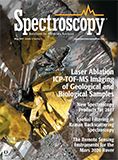
The Future of Neurodegenerative Disease Research and the Role of IR Imaging
May 21st 2025In the final part of this three-part interview, Ayanjeet Ghosh of the University of Alabama and Rohit Bhargava of the University of Illinois Urbana-Champaign talk about the key performance metrics they used to evaluate their model, and what the future of neurodegenerative disease research looks like.
Describing Their Two-Step Neural Model: An Interview with Ayanjeet Ghosh and Rohit Bhargava
May 20th 2025In the second part of this three-part interview, Ayanjeet Ghosh of the University of Alabama and Rohit Bhargava of the University of Illinois Urbana-Champaign discuss how machine learning (ML) is used in data analysis and go into more detail about the model they developed in their study.
AI and Infrared Light Team Up to Advance Soil Carbon Monitoring
May 19th 2025A team of international researchers has developed a faster, more accurate method to analyze soil carbon fractions using mid-infrared spectroscopy and deep learning. Their approach preserves the chemical balance of soil organic carbon components, paving the way for improved climate models and sustainable land management.

.png&w=3840&q=75)

.png&w=3840&q=75)



.png&w=3840&q=75)



.png&w=3840&q=75)
